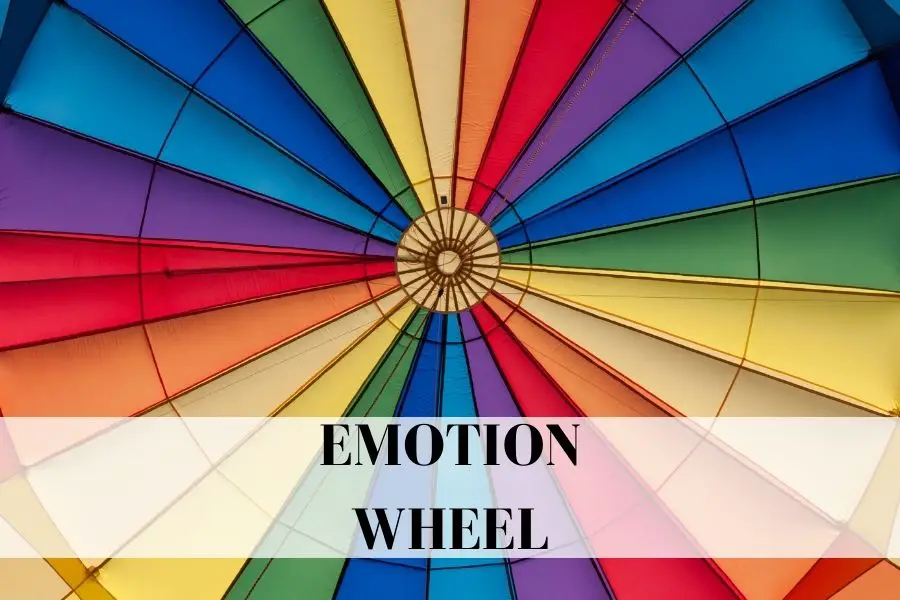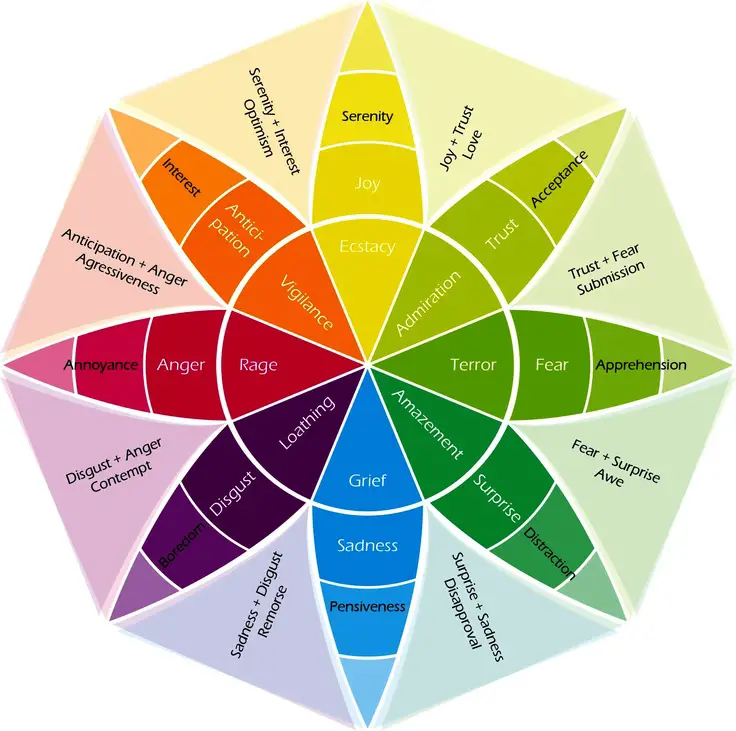
7 Emotion Wheel Insights: Navigating Your Feelings Through Color Emotion Wheel
Ever felt overwhelmed by a whirlwind of emotions?
I’ve been there! That’s when I discovered the Color Emotion Wheel, a beautiful tool that translates our feelings into a spectrum of colors.
Through today’s post, we’ll journey together into its vibrant depths, revealing ways to better understand and articulate our innermost sensations.
Whether you’re aiming to boost your emotional intelligence or find fresh means to express yourself, this guide is for you.
Ready to dive into this colorful world?
Let’s go!

What is the Emotion Wheel?
The Emotion Wheel, often referred to as the “Color Emotion Wheel,” is a visual representation of the spectrum of human emotions. Each color on the wheel corresponds to a specific emotion, allowing individuals to identify and understand their feelings better.
Historical Background of the Emotion Wheel
From ancient civilizations intertwining fiery red with passion to the Greeks and Chinese recognizing the bond between emotions and colors, the Emotion Wheel’s legacy has evolved over centuries. Today’s vibrant Color Emotion Wheel is a testament to our age-old quest to understand our feelings, offering a colorful map of our shared human experience.
Importance of Understanding Emotions
Understanding our emotions is crucial. It aids in self-awareness, promotes mental well-being, and fosters better interpersonal relationships. By recognizing our feelings, we can address them appropriately and lead a more balanced life.

The Basics of the Color Emotion Wheel
At its core, the Color Emotion Wheel is a visual guide that paints our feelings with a spectrum of shades. If you’ve ever wondered how colors and emotions tangle and dance, this is where the magic unfolds.
- Primary Emotions: Just as we have primary colors, we have core feelings. These anchor the wheel and lay the foundation:
- Red for anger.
- Blue for sadness.
- Yellow for joy… and so on.
- Layers and Depth: As we move outward from the center:
- Colors deepen, mirroring the complexity of our emotions.
- Blended colors showcase mixed feelings, like the turquoise of calm curiosity.
- Shades of Intensity: Think of it as a gradient:
- Pale colors hint at subdued emotions.
- Richer hues signify intense feelings.

Delving into the Colors
Let’s dive right in and explore the wonderful world of the Color Emotion Wheel, where each color opens up a whole new dimension of feelings and emotions, helping us to better understand and navigate our emotional world.
Red: The Passionate Spectrum
Red, often associated with love and anger, represents intense emotions. It’s the fiery burst of passion or the simmering rage that bubbles beneath the surface. Ever felt your cheeks turn red when embarrassed? That’s the power of the red spectrum.
Blue: The Calm Depths
Blue signifies tranquility, sadness, and depth. It’s the serene lake reflecting the sky or the melancholic tune that tugs at your heartstrings. When you’re feeling blue, you’re diving into the calm, yet profound depths of this emotion.
Yellow: The Joyful Radiance
Yellow is the color of joy, energy, and optimism. It’s the bright sun shining down, filling you with hope and happiness. When life gives you lemons, remember the radiant energy of yellow.
Green: The Balance of Nature
Green represents balance, growth, and envy. It’s the fresh leaves sprouting in spring or the pang of jealousy when comparing oneself to others. Green reminds us of nature’s balance and the need for personal growth.
Purple: The Mysterious Realm
Purple stands for mystery, luxury, and introspection. It’s the enigmatic aura of the unknown or the luxurious feel of velvet. Dive into the purple realm when you’re feeling introspective.
Orange: The Energetic Burst
Orange is all about energy, enthusiasm, and warmth. It’s the burst of laughter among friends or the warm hug from a loved one. Embrace the orange when you need a pick-me-up.
Pink: The Gentle Embrace
Pink symbolizes love, gentleness, and compassion. It’s the tender touch of a mother or the blush of a first love. Let pink envelop you in its gentle embrace when you seek comfort.
How to Read the Emotion Wheel
Now that we’re familiar with the colorful landscape of our emotions, let’s move on to the practical stuff – how to actually use the Emotion Wheel to our advantage in everyday life.
- Start at the Center: The core or center typically represents primary or basic emotions. These are the foundational feelings.
- Move Outwards: As you move toward the outer layers, emotions often become more nuanced and complex, representing blends or variations of the core emotions.
- Examine the Colors: Each color or shade signifies a specific emotion. Darker shades usually indicate more intense feelings, while lighter ones suggest milder emotions.
- Blended Sections: Areas, where colors merge, represent combined emotions. For instance, if joy (yellow) and trust (blue) merge, you might get a shade representing love or affection.
- Use as a Reference: When feeling a certain way but struggling to name the emotion, refer to the wheel. Match your feeling with a color or section to give it a name.
Identifying Your Feelings
Using the Color Emotion Wheel is simple. When overwhelmed with emotions, visualize the wheel and identify the color that resonates most with your current feeling. This helps in pinpointing the exact emotion you’re experiencing.
Addressing Emotional Needs
Once you’ve identified your emotion, address it. If you’re feeling blue, maybe you need some quiet time. If red with anger, perhaps some deep breaths or a walk would help. The wheel not only identifies but also guides in addressing emotions.
Check out my blog post 14 Simple Habits to Help You Get Your Life Together
Insight #1: Recognizing Core Emotions
Recognizing our core emotions is a fundamental step in emotional intelligence. It opens the door to deeper self-awareness, effective communication, and personal growth.
- At the heart of the Color Emotion Wheel are fundamental emotions such as joy, sadness, anger, and fear.
- These are our raw, unfiltered responses to the world around us. They’re instinctual, powerful, and often the first to surface in any given situation.
Understanding Their Impact
- Recognizing these core emotions is akin to having a compass in an often tumultuous emotional sea.
- By pinpointing the root of what we’re feeling, we’re better equipped to navigate complex emotional landscapes and respond to situations with clarity and wisdom.
The Ripple Effect
- Just as a pebble creates ripples in a pond, our core emotions can influence a range of related feelings and behaviors.
- For instance, beneath anger might lie feelings of sadness or fear. Unraveling these layers can provide valuable insights and foster emotional healing.
Tools For Identification
By matching our feelings to a specific color or section on the wheel, we can bring a sense of order and understanding to what can sometimes feel like an overwhelming emotional experience.
Insight #2: Understanding Emotional Intensity
Emotional intensity refers to how strongly we experience and exhibit our emotions. Like the varied shades on a painter’s palette, our feelings can range from soft pastels to bold, vibrant hues.
The Role of Core Depth
- In the Color Emotion Wheel, the depth of the color often symbolizes the intensity of the emotion.
- Lighter shades represent more subtle, gentle feelings, while darker, richer hues depict stronger, more profound emotions.
The Spectrum of Intensity
- Just as a spectrum contains a range of wavelengths, our emotional world encompasses a vast array of intensities.
- This spectrum allows us to understand that our feelings can ebb and flow, changing in strength and depth based on various factors like context, personal history, and individual temperament.
Identifying Triggers
- By recognizing the intensity of our emotions, we can also identify specific triggers that may heighten or lessen these feelings.
- This awareness can be particularly useful in managing emotions that might feel overwhelming or difficult to handle.
Embracing the Range
- Understanding emotional intensity empowers us to embrace the full range of our feelings, from the gentle whispers of calm to the roaring waves of anger.
- By accepting and acknowledging the intensity of our emotions, we open the door to greater self-compassion and emotional well-being.
Insight #3: The Complexity of Mixed Emotions
Ah, the intricate dance of emotions!
The Magic of Blended Colors
- On the Color Emotion Wheel, mixed emotions are represented by the blended colors that arise from the merging of primary and secondary emotions.
- Just as green emerges from the union of blue and yellow, emotions like apprehension can be seen as a mix of fear and anticipation.
Navigating the Layers
- Mixed emotions often have multiple layers, each contributing to the tapestry of our emotional response.
- By exploring these layers, we gain a deeper understanding of our reactions and can navigate our emotional world with greater ease.
Accepting Emotional Ambiguity
- Mixed emotions are a testament to the complexity of human feelings.
- Embracing these multifaceted emotions, even when they seem contradictory, allows us to fully experience and process our emotional responses.
The Interplay of Emotions
- The interplay of different emotions in mixed feelings can offer valuable insights into our inner workings and can be a powerful tool for self-reflection and personal growth.
- By examining the intricate dance of our mixed emotions, we can uncover hidden aspects of ourselves and foster a deeper connection with our emotional selves.
Download the Emotion Wheel PDF HERE
Insight #4: Emotional Awareness and Mindfulness
By embracing emotional awareness and mindfulness, we are choosing to step into the light of understanding, where each emotion is acknowledged, accepted, and honored. This is not just an exploration of our emotional selves, but also an invitation to cultivate a rich, fulfilling emotional life.
The Gift of Mindfulness
- Mindfulness invites us to be present with our emotions, observing them without judgment.
- This practice allows us to experience our feelings fully, understanding their ebb and flow without being overwhelmed by them.
Patterns and Triggers
- As we deepen our emotional awareness, we begin to notice patterns and triggers that influence our emotional responses.
- This knowledge is invaluable, providing us with the opportunity to address and modify these patterns for improved emotional well-being.
A Journey of Self-Discovery
- Emotional awareness and mindfulness are integral to our journey of self-discovery.
- These practices foster a deep connection with our inner world, revealing the layers and nuances of our emotional landscape.
Insight #5: Communication and Expression
Harness the power of the Color Emotion Wheel to communicate and express emotions with clarity and depth, and in doing so, build a world where emotional expression is celebrated and cherished.
The Wheel as a Translator
- The Color Emotion Wheel can be used as a translator, helping us to articulate our feelings with precision and accuracy.
- By identifying the color that corresponds with our emotions, we can find the words to express even the most complex feelings.
Enhancing Interpersonal Relationships
- Emotional expression is key to building strong, meaningful relationships.
- When we communicate our emotions clearly, it opens the door to empathy and mutual understanding, strengthening the bond between us and our loved ones.
The Beauty of Vulnerability
- Expressing our emotions requires vulnerability, a willingness to open up and show our true selves.
- This vulnerability, while sometimes daunting, is a powerful tool for fostering authentic connections and emotional intimacy.
Empowering Our Emotional Voice
- The Color Emotion Wheel empowers us to give voice to our emotions and to express them in a way that feels true and authentic.
- In doing so, we not only enrich our own emotional lives but also contribute to a more emotionally aware and compassionate world.
Insight #6: Emotional Healing and Therapy
Embarking on a journey of emotional healing can often feel like navigating a labyrinth—complex and filled with twists and turns. However, with the right tools, like the Color Emotion Wheel, and the support of therapy, this journey can become a transformative process of self-discovery and healing.
Uncovering Hidden Emotions
- Therapy, in conjunction with the wheel, can help us uncover hidden or suppressed emotions, bringing them to the surface for examination and processing.
- This process of uncovering and confronting our emotions is often the first step toward healing.
Transforming Pain Into Growth
- Emotional healing isn’t just about alleviating pain; it’s about transforming that pain into growth and self-discovery.
- By exploring our emotional landscape, we can gain insights into our past, understand our present, and shape a more positive future.
The Power of Emotional Release
- Expressing our emotions, whether through talking, writing, or other creative outlets, is a crucial aspect of emotional healing.
- The act of expression can provide a release, allowing us to let go of pent-up emotions and find a sense of peace and balance.

Insight #7: Daily Applications and Emotional Tracking
Incorporating emotional awareness into our daily lives can seem like a daunting task. Yet, the beauty of the Color Emotion Wheel and the practice of emotional tracking is that they make this process accessible and manageable, transforming it into a daily ritual of self-discovery and balance.
The Importance of Emotional Tracking
- Emotional tracking involves regularly recording our emotions, and this practice can be immensely beneficial.
- It allows us to identify patterns and triggers, ultimately giving us greater control over our emotional responses.
Tools For Emotional Tracking
- There are various tools available for emotional tracking, from traditional journaling to digital apps designed specifically for this purpose.
- Whichever method you choose, the key is consistency and honesty in recording your emotions.
Integrating Emotional Awareness
- By integrating emotional awareness into our daily routine, we can foster a deeper connection with ourselves.
- This ongoing practice of self-reflection and emotional management can lead to a more balanced, harmonious life.

Download Emotion Wheel Printable HERE
Frequently Asked Questions
What is the primary purpose of the Color Emotion Wheel?
It helps individuals identify and understand their emotions better.
Can the wheel be used by everyone?
Yes, it’s a universal tool suitable for all age groups and backgrounds.
Does each color represent only one emotion?
No, each color can signify a range of emotions, but they all fall within a specific spectrum.
How often should one refer to the Emotion Wheel?
As often as needed. Whenever you’re feeling overwhelmed or confused about your emotions, the wheel can guide you.
Is the Emotion Wheel a replacement for professional therapy?
No, it’s a tool for self-awareness. If you’re struggling with your emotions, it’s always best to seek professional help.
What is the best emotion wheel?
The term “best” can be subjective, as the ideal emotion wheel depends on an individual’s needs and the context in which it’s used. However, one of the most recognized and comprehensive emotion wheels is Dr. Robert Plutchik’s Wheel of Emotions. It showcases eight primary emotions and their varying intensities, offering a visual representation of the depth and range of human emotions. Still, it’s essential to choose a wheel that resonates with you and serves your specific goals, whether it’s personal insight, therapy, or emotional education.
How many emotions do we have?
Human emotions are vast and complex, and the exact number can vary based on different psychological models and theories. Dr. Robert Plutchik identified eight primary emotions: joy, trust, fear, surprise, sadness, anticipation, anger, and disgust. However, as these primary emotions blend and vary in intensity, they can give rise to many more nuanced feelings. Some models list a few basic emotions, while others may categorize dozens. In essence, while there are several universally recognized core emotions, the total number expands when considering their subtle variations and combinations.
How does the emotion wheel work?
The emotion wheel is a visual representation of the spectrum of human emotions, showcasing how they relate to each other. It works by categorizing emotions into primary, secondary, and tertiary emotions.
Primary Emotions: These are the core emotions such as happiness, sadness, anger, fear, surprise, and disgust.
Secondary Emotions: These are the emotions that arise as a blend of the primary emotions, such as pride (a mix of happiness and surprise) or guilt (a mix of sadness and fear).
Tertiary Emotions: These are even more complex emotions that arise from a mix of primary and secondary emotions, such as optimism (a mix of anticipation and joy) or loneliness (a mix of fear and sadness).
What is an alternative to the feeling wheel?
Emotion Thermometer: Scale of 0-10 to gauge emotion intensity.
Emotion Journals: Writing to explore emotional patterns.
Mood Tracking Apps: Digital tool to track emotional changes.
Mindfulness Practices: Techniques to ground and understand emotions.
How do you use the Gottman emotion wheel?
The Gottman Emotion Wheel, created by psychologists John and Julie Gottman, is used to help individuals and couples develop a deeper understanding of their emotional experiences. Here’s how you can use it:
Identify the Basic Emotion:
Start by looking at the innermost circle and identify the basic emotion you are feeling, such as sad, mad, or glad.
Refine the Emotion:
Move outward to the second circle to find a more specific word that describes your emotion, such as frustrated, hurt, or joyful.
Explore the Underlying Cause:
Once you have identified the specific emotion, explore what might be causing that emotion. What happened to make you feel that way?
Communicate the Emotion:
If you are comfortable, share your emotions and their causes with someone you trust. This can foster better understanding and empathy.
Resources
Appropriate emotional labelling of non-acted speech using basic emotions, geneva emotion wheel and self assessment manikins. (2011, July 1). IEEE Conference Publication | IEEE Xplore. https://ieeexplore.ieee.org/abstract/document/6011929
Emotion Wheel Attention-Based Emotion Distribution Learning. (2021). IEEE Journals & Magazine | IEEE Xplore. https://ieeexplore.ieee.org/abstract/document/9566841
Willcox, G. (1982, October). The Feeling Wheel. Transactional Analysis Journal, 12(4), 274–276. https://doi.org/10.1177/036215378201200411






